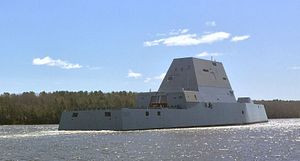The biggest and most technologically advanced destroyer in U.S. naval history, the 16,000-ton next generation guided-missile destroyer USS Zumwalt, has suffered an engineering casualty during preparation for at-sea trials on September 19, the U.S. Navy said in a statement to USNI News.
The repairs could take up to two weeks, according to the U.S. Navy. “The crew discovered the casualty after detecting a seawater leak in the propulsion motor drive lube oil auxiliary system for one of the ship’s shafts,” the statement reads.
The discovery was made while the new warship was docked at the U.S. naval base in Norfolk, Virginia. “The built-in redundancy of the ship’s propulsion plant allows this first-in-class ship to operate with multiple engine configurations,” the statement said. “However, it was determined that the repairs should be completed in port prior to the ship transiting to sea.”
Difficulties like an engineering casualty are apparently not uncommon for the lead vessels of a new class of warships. “Repairs like these are not unusual in first-of-class ships during underway periods following construction. Zumwalt will conduct the repairs at Naval Station Norfolk prior to getting underway for training and certification operations,” the statement notes.
The repairs will not affect the October commissioning date of the ship, U.S. Navy officials emphasize. As I reported earlier (See: “US Navy’s New Stealth Destroyer Soon to Test Weapon Systems”):
America’s latest surface warship successfully completed builder’s trials in March 2016 and December 2015 in the Atlantic Ocean. It completed inspection and acceptance trials — including rough-weather trials — with the Navy’s Board of Inspection and Survey in April of this year. The ship is slated to achieve initial operating capability in October.
Following the USS Zumwalt’s commissioning, she will be transferred to San Diego, California, where ship’s combat systems will be installed. The warship is slated to join the U.S. Navy’s surface fleet in 2018.
The Zumwalt-class will provide a major boost to the U.S. Navy surface fleet’s fire power. “Each ship features a battery of two Advanced Gun Systems (AGS) firing Long-Range Land Attack Projectiles (LRLAP) that reach up to 63 nautical miles [72 miles, 115 kilometers], providing a three-fold range improvement in naval surface fires coverage,” according to the U.S. Navy website.
The U.S. Navy is working on two additional Zumwalt-class guided-missile destroyers, all of which will also be home-ported in San Diego. The total procurement costs for the lead vessel of the class will likely exceed $4 billion. Cost estimated for the other two vessels are $2.8 billion and $2.4 billion respectively.
































